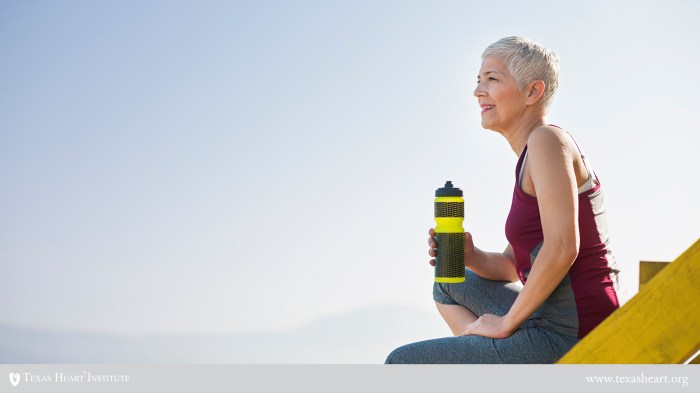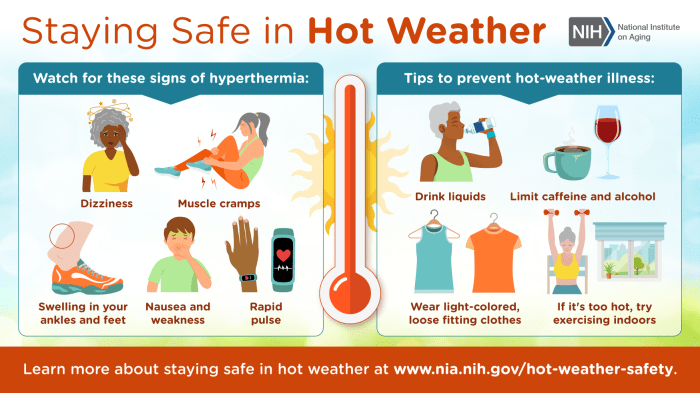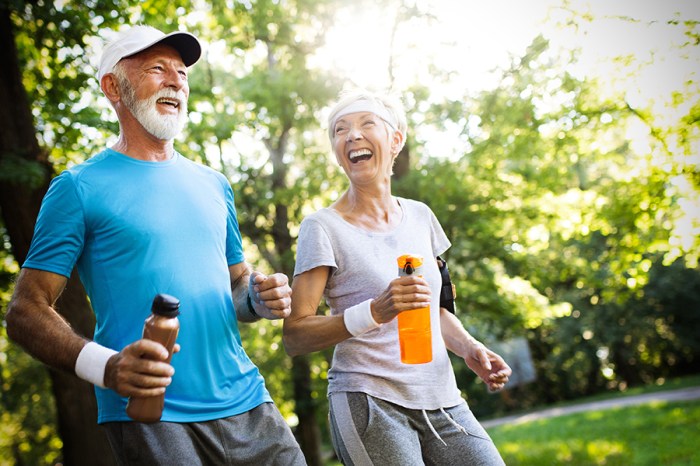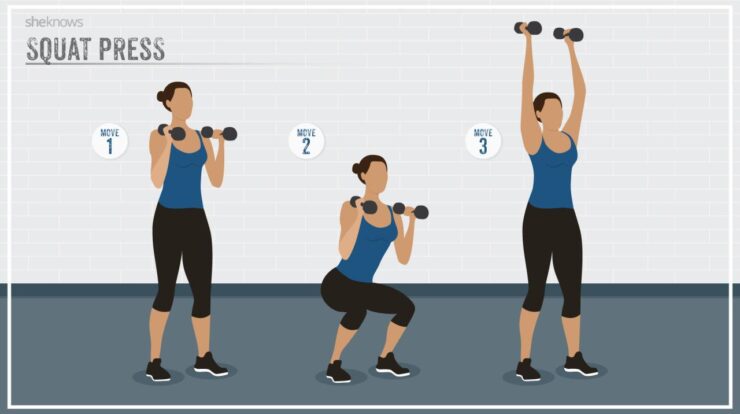Exercising safely in hot weather for seniors requires special considerations to prevent heat-related illnesses. This guide provides essential tips and information to help older adults stay active and healthy during the summer months.
Understanding the risks, staying hydrated, choosing the right time and place to exercise, wearing appropriate clothing and gear, listening to your body, and cooling down properly are crucial for safe summer workouts.
Understanding the Risks of Exercising in Hot Weather
Exercising in hot weather poses unique challenges to the body. Understanding the physiological changes that occur during exercise in hot weather is crucial for seniors to stay safe and healthy.
During exercise, the body produces heat as a byproduct. In hot weather, the body’s ability to dissipate this heat is reduced, leading to a rise in core body temperature. Prolonged exposure to high temperatures can result in heat-related illnesses, such as heat exhaustion and heatstroke.
Factors Increasing the Risk of Heat-Related Illnesses
Certain factors can increase the risk of heat-related illnesses in seniors:
- Age:Seniors have a reduced ability to regulate body temperature and are more susceptible to heat-related illnesses.
- Obesity:Excess body fat insulates the body, making it harder to dissipate heat.
- Certain Medical Conditions:Conditions such as heart disease, diabetes, and high blood pressure can impair the body’s ability to regulate temperature.
- Medications:Some medications, such as diuretics and antihistamines, can increase the risk of dehydration and heat-related illnesses.
Staying Hydrated
Staying hydrated is crucial for maintaining optimal health, especially during physical activity in hot weather. Dehydration can lead to various health complications, including heat cramps, heat exhaustion, and even heatstroke. To prevent these risks, it is essential to prioritize hydration before, during, and after exercise.
When the summer heat is at its peak, it’s important for seniors to exercise safely in hot weather. Staying cool and hydrated is crucial to prevent heat-related illnesses. For more tips on how to stay cool in summer, visit our article on staying cool in summer for seniors . By following these guidelines, seniors can enjoy the benefits of exercise without putting their health at risk.
paragraphThe recommended fluid intake for individuals exercising in hot weather varies depending on factors such as intensity, duration, and environmental conditions. However, as a general guideline, it is advisable to consume approximately 8 ounces of fluid every 15-20 minutes during exercise.
For seniors, exercising safely in hot weather is paramount. Along with appropriate attire and hydration, it’s crucial to be aware of sun safety tips for older adults. Sun safety measures like wearing protective clothing, sunglasses, and sunscreen can help prevent heat-related illnesses and skin damage.
By incorporating these tips, seniors can enjoy the benefits of outdoor exercise while staying safe and healthy in hot weather.
Types of Fluids
Not all fluids are created equal when it comes to hydration. Water remains the most effective choice for replenishing fluids lost through sweat. However, sports drinks can also be beneficial, as they contain electrolytes that help replace minerals lost during exercise.
Avoid sugary drinks, such as soda or juice, as they can dehydrate you further.
Signs and Symptoms of Dehydration
Recognizing the signs and symptoms of dehydration is essential for preventing serious health complications. Common indicators include:
- Dry mouth
- Thirst
- Fatigue
- Headache
- Dizziness
- Muscle cramps
- Nausea
If you experience any of these symptoms, it is important to stop exercising and seek medical attention immediately.
Seniors planning on exercising outdoors in hot weather should take precautions against heatstroke, a life-threatening condition. It’s essential to stay hydrated, wear loose-fitting clothing, and avoid exercising during peak heat hours. More tips for heatstroke prevention for seniors can be found here . By following these guidelines, seniors can enjoy the benefits of exercise without putting their health at risk.
Preventing Dehydration
Preventing dehydration is relatively straightforward with proper planning and preparation. Here are some tips:
- Drink plenty of fluids before, during, and after exercise.
- Choose water or sports drinks over sugary beverages.
- Wear loose, lightweight clothing that allows for breathability.
- Exercise during cooler hours of the day, if possible.
- Take breaks in the shade or air-conditioned areas to cool down.
Choosing the Right Time and Place to Exercise: Exercising Safely In Hot Weather For Seniors
Exercising in hot weather poses unique challenges for seniors, making it crucial to choose the right time and place to minimize heat-related risks.
Avoid Exercising During the Hottest Hours of the Day
The sun’s intensity is strongest between 10 am and 4 pm, making these hours the hottest. During this time, the body must work harder to regulate its temperature, increasing the risk of heat-related illnesses.
Best Times to Exercise in Hot Weather
- Early morning (before 10 am)
- Late evening (after 4 pm)
- Indoors in an air-conditioned facility
Choose a Shaded or Air-Conditioned Location
Exercising in direct sunlight increases heat exposure and the risk of heat-related illnesses. Choose shaded areas such as parks, covered walkways, or indoors in an air-conditioned gym.
Wearing Appropriate Clothing and Gear
Exercising in hot weather requires appropriate clothing and gear to stay comfortable and safe. Choosing the right attire can help regulate body temperature, prevent dehydration, and protect from the sun’s harmful rays.
Loose-fitting, Lightweight, and Moisture-wicking Clothing
- Loose-fitting clothing allows for better air circulation, keeping you cooler.
- Lightweight fabrics, such as cotton or linen, help reduce heat retention.
- Moisture-wicking fabrics, like polyester or nylon, draw sweat away from the body, keeping you dry and comfortable.
Hat and Sunscreen, Exercising safely in hot weather for seniors
Protecting your head and skin from the sun is crucial.
- Wear a wide-brimmed hat to shade your face, neck, and ears.
- Apply sunscreen with an SPF of 30 or higher to exposed skin, including your face, arms, and legs.
Listening to Your Body

When exercising in hot weather, it’s crucial to pay attention to your body’s signals and take breaks as needed. Ignoring these signals can lead to heat-related illnesses, which can be serious and even life-threatening.
Recognizing the signs and symptoms of heat-related illnesses is essential. These include:
Heat Cramps
- Muscle cramps in the legs, abdomen, or arms
- Sweating
- Fatigue
Heat Exhaustion
- Heavy sweating
- Weakness
- Nausea
- Dizziness
- Headache
Heatstroke
- High body temperature (103°F or higher)
- Hot, red, dry, or damp skin
- Rapid pulse
- Loss of consciousness
li>Confusion
If you experience any of these symptoms, stop exercising immediately and seek shade or a cool place. Drink plenty of fluids and rest until you feel better. If symptoms persist or worsen, seek medical attention immediately.
Cooling Down After Exercise

Cooling down after exercising in hot weather is crucial for preventing heat-related illnesses and promoting recovery. Here’s how to cool down properly:
Gradual Reduction of Intensity
- Slowly decrease the intensity of your exercise over 5-10 minutes. This helps your body transition from a high-heat state to a resting state.
Cool Water Immersion
Submerge your arms and legs in cool water for 10-15 minutes. This helps lower your core body temperature quickly.
Ice Packs
- Apply ice packs to your neck, armpits, and groin areas. These areas contain large blood vessels that allow for rapid cooling.
Rest in a Cool Place
After cooling down, rest in a cool, air-conditioned room or in the shade for at least 30 minutes. This allows your body to continue cooling down and replenish fluids.
Final Conclusion

By following these guidelines, seniors can enjoy the benefits of exercise without putting their health at risk. Staying active during hot weather helps maintain physical fitness, mental well-being, and overall quality of life.
Essential FAQs
How much water should seniors drink before, during, and after exercise in hot weather?
Seniors should drink 2-3 cups of water 2 hours before exercise, 1 cup every 20 minutes during exercise, and 2-3 cups after exercise.
What are the signs of dehydration?
Signs of dehydration include thirst, dry mouth, headache, fatigue, and dizziness.
What should seniors do if they experience signs of heat-related illness?
If seniors experience signs of heat-related illness, they should stop exercising, move to a cool place, drink plenty of fluids, and seek medical attention if symptoms persist.





